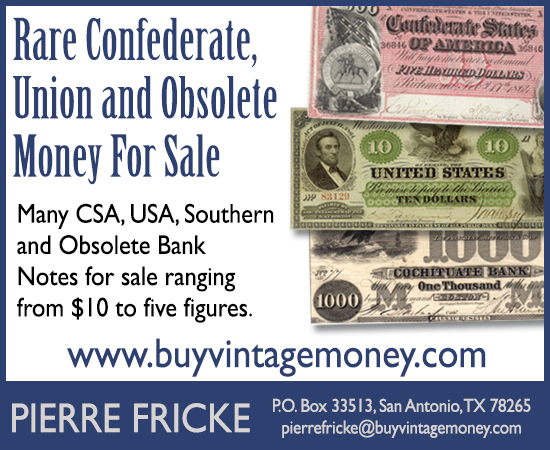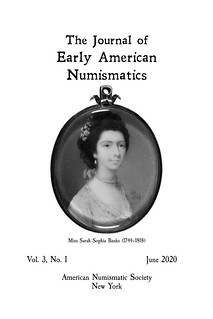
PREV ARTICLE
NEXT ARTICLE
FULL ISSUE
PREV FULL ISSUE
JOURNAL OF EARLY AMERICAN NUMISMATICS JUNE 2020The latest issue of JEAN, the Journal of Early American Numismatics has been published by the American Numismatic Society. Here is the table of contents and an excerpt from the Editor’s Preface by Christopher R. McDowell. This issue features a very important article by Jeff Rock on the collection of Miss Sarah Sophia Banks at the British Museum. -Editor Editor’s Preface
Collecting American Colonial Coins in Eighteenth-Century England
Regulator and Regulated: The Monetary Conditions of Goldsmith
Thomas Shields and the Successful Circulation of Foreign Gold Coinage
Proposed Design of a Commemorative Medal of the Battle of Pensacola (1781) by the Royal Academy of San Carlos Mexico
Aztec Influence in Early Spanish Colonial Four-Reales Coinage, 1538–1542
The Montreal Medal of Songose: A Case Study of Established Numismatic Lore
[I]t is the beautiful young woman on the cover who began acquiring what is arguably the most important intact coin collection ever assembled by a private individual. Her collection, as you will learn, is not only important for its holdings of British treasures, but also its American colonial pieces. Before today, few Americans had the pleasure of seeing Miss Banks’ American coins, but here they are for our subscribers to enjoy along with Jeff Rock’s brilliant descriptions and analysis. Jeff ’s article has been in the works for a long time. The American Numismatic Society, through JEAN’s publisher, Andrew Reinhard, worked with the British Museum for over a year in order to bring you the fantastic images of Miss Banks’ collection in this issue. Jeff traveled to England at his own expense, and spent time at both museums where he tracked down, selected, and examined all the coins presented here. Many of the coins you will see in his article have never before been photographed or studied by American numismatists. I wish to thank the ANS, Andrew, and Jeff for their efforts and financial commitment in helping to bring this important article to our subscribers. Miss Sarah Sophia Banks, as you shall learn, was not a hoarder, but an astute, sophisticated collector—she collected with a purpose, she was not merely acquiring stuff. And, like many of you, she clearly enjoyed spending her leisure time with her collection, lovingly organizing and recording every specimen. Thus, her existing notes (some are missing) provide us with a rare opportunity to learn how a late eighteenth and early nineteenth-century collection of American colonial coins was put together in Europe. Through Jeff ’s research we learn which American coins were available, how much they cost, and who was selling, trading, or giving them away. In many instances, the only reason mint state or near mint state specimens of some American coins have survived is because people like Miss Banks saved them for us. Jeff does an excellent job in explaining how English collectors helped preserve American colonial coins. While Jeff discusses several other collectors and writers, the star of the show is Miss Banks. Jeff ’s article takes up the bulk of this edition of JEAN, but it is by no means the only thing readers have to look forward to in this issue! Dr. Jesse Kraft takes a look at Philadelphia goldsmith Thomas Shields’ business records to inform us on gold coin regulating. With much hubris, Ye Editor thought he knew pretty much all there was to know about pre-Revolutionary gold coin regulation—I am now somewhat humbled. There was far more to the gold coin regulating business than even I (with my vivid imagination) could have ever dreamed of. I thought the business consisted mostly of plugging gold coins to raise their weight, and was totally unaware that the bulk of the work was doing just the opposite. Who knew that regulators spent more time and made more money shaving gold coins than plugging them? Business ledgers like those of Mr. Shields are a treasure trove of information that are beginning to open our eyes to the rich history of the coins we collect and study. I would be remiss if I did not add that Dr. Kraft is the new assistant curator of American numismatics at the ANS. I wish him well in this job, and I am sure all our subscribers do as well. Although this is his first article in JEAN, I do not think it will be his last. I am currently working on a book to update C. Wyllys Betts’ work on American colonial medals. As I slowly slog my way through each medal, I have come to appreciate Spain’s tradition of proclamation and commemorative medals relating to the Americas. Some of the medals listed by Betts were never produced. This issue of JEAN presents an article dealing with an unlisted Betts medal; one that was never actually minted—the proposed medal commemorating the battle of Pensacola, in British West Florida. This proposed piece memorializes an event not taught in schools, viz. the successful Spanish attack on Pensacola during the American Revolution. This article was prepared by Dr. Ángel O. Navarro Zayas from Ponce, Puerto Rico. I am informed by several sources that he is the numismatic expert on that island. As a native speaker of Spanish, his perspective on Spain’s American numismatic tradition is invaluable. This is the second issue in a row where he has shared something with us, and I hope he will continue that trend. We are also lucky to have another article on Spanish coinage in this issue. This article, written by a new contributor, Philip Ellsworth, was a real treat for me and the other editors. We all loved it. One of our points of emphases over the last two years at JEAN has been to explore Spanish coinage in greater depth. Mr. Ellsworth’s article is about as deep a dive as you can take; a thrilling adventure into pre-Columbian Aztec influence on Spanish coinage. As it turns out, one year the prepared dies for the Mexico City mint did not arrive from Spain, and the mint turned to local Aztec workers to help fashion the new dies. The resulting coins from this clash of cultures are fascinating! I am sure you will enjoy reading and learning about this unique moment in history as much as we have. I save the article from my friend Julia Casey for last. Julia has been a phenomenal addition to JEAN’s editorial team. As every author can attest, she has made everything published in these pages better. Her research skills are unsurpassed. Coincidentally, Julia is from a small town in New York State called Ballston Spa that has a wonderful numismatic story attached to it; the discovery of a Montreal Medal, Betts-431, issued to a Native American warrior from the Mohican Tribe known only as Songose. This specific medal has been studied and written about by many fine numismatic scholars. Julia shows us that there is more to the story, and in doing so makes the point that we should not just assume we know everything there is to know about colonial coins and medals. Each coin and each medal has a rich history that we have only just started to understand.
For more information on the American Numismatic Society, see:
For more information on the Journal of Early American Numismatics, see:

Wayne Homren, Editor The Numismatic Bibliomania Society is a non-profit organization promoting numismatic literature. See our web site at coinbooks.org. To submit items for publication in The E-Sylum, write to the Editor at this address: whomren@gmail.com To subscribe go to: https://my.binhost.com/lists/listinfo/esylum All Rights Reserved. NBS Home Page Contact the NBS webmaster 
|
